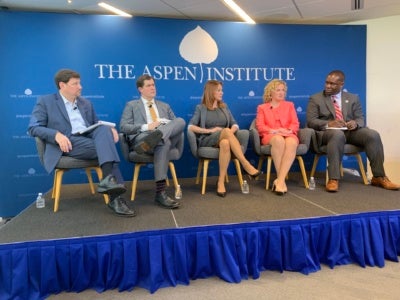
Education policy needs an aperture as wide as America’s vast expanse, but national conversations often center on the needs of complex urban districts and rapidly diversifying suburbs, with rural schools treated as an afterthought. Federal agencies, think tanks, foundations, and large media outlets are primarily located in cities, limiting the context on which we draw.
Listening to an interesting panel @AspenEdSociety on #ruralschools w/ @SanfordLJohnson @jillian4supt @KirstenBaesler @smarick. First aha moment: the thinktanks, the foundations, the big media outlets are all in the big cities; most ed orgs are completely ignorant about rural ed.
— Silas Kulkarni (@SilasKulkarni) April 10, 2019
On April 11, 2019, Aspen Institute’s Education & Society Program hosted a panel based on a book co-edited by Andy Smarick and Michael McShane, No Longer Forgotten: The Triumphs and Struggles of Rural America. Our panelists included two elected state superintendents, Jillian Balow of Wyoming and Kirsten Baesler of North Dakota, and Sanford Johnson, deputy director of Mississippi First, an education policy and advocacy organization. Each of these experts had engaged deeply with Aspen before, bringing perspective from rural education into our work, but this is the first time we have organized an event focused on rural education.
We take much for granted that is not practical for educators and students in rural communities. A recent EdWeek article illustrated the long distances students must traverse if they miss a school bus and the difficulties of even arriving at the bus stop, with families leaving before dawn to reach the stop on time.
It is not uncommon for a school principal to also be the basketball coach and the federal programs manager. Understanding this context puts a different gloss on the attractiveness of and even feasibility of competitive grants, not to mention the regular responsibilities of producing data for ESSA compliance. Policymakers should recognize the sparse infrastructure affecting many rural communities—little to no public transit, fewer libraries and arts organizations, and, ironically, fresh-food deserts—gives schools a central role in rural life that is different than in other locales.
Sixty million people live in rural communities in every part of America, serving approximately twenty percent of the overall public school population. Rural America comprises the Deep South, Appalachia, the Midwest, the Northern Plains, New England, the Central Valley of California, and more, regions that wildly differ from one another in both geography and culture. There is tremendous diversity between rural communities even as there is less diversity within each one.
Place as Part of Identity and Implications for Equity
The idea of rural communities as deeply rooted in place arose several times during the panel. Residents know and take care of one another and feel more cohesion than is reported in suburbs or cities. Rural schools are critical to community infrastructures and a vital resource for strengthening bonds. They serve as hubs for activity and engagement.
Rural communities should not be seen as “places that you escape” @SanfordLJohnson Rural communities tend to love their schools and feel connected to them #RuralSchools often are the sole hubs of social and civic activity in many rural areas.
— Giselle Lundy-Ponce (@LundyPonce) April 10, 2019
This speaks to the important role of place as part of one’s identity, a topic we have been exploring to frame robust conversations on equity. It is common for national education conversations to focus on schools’ role in affirming students’ multiple identities, including race, ethnicity, and gender.
But identity is also deeply influenced by place, especially in rural areas that are far from other communities; these areas have their own distinct history and traditions that deserve to be affirmed in school. Conversations about equity are increasingly contested spaces and tend to be focused on race, but we must not forget that equity encompasses all aspects of diversity; every community deserves dignity and respect.
“Race and identity are important considerations in equity in education conversations. Place is an important factor too, especially when focused on rural education.” #ruralschools @AspenEdSociety
— Brie Doyle (@doyle_brie) April 10, 2019
Equity implications run in both directions: communities, including rural ones, want to tailor actions to their own sense of what’s needed; policies regarding school improvement and human capital often bring urgency and additional resources, but often displace local judgment.
At the event, Andy Smarick noted that rural students are more likely than peers to graduate from high school but less likely to go to college. Understanding why—and how rural families and communities see these issues—is critical to designing solutions that advance equity, as opposed to thinking that equity means just one thing (that’s decided far away from rural communities’ realities).
A Plea for Greater Pluralism
Panelists spoke about rural schools and their communities wanting more acknowledgment for their positive attributes and greater respect for pluralism regarding priorities. When schools form the center of a community’s workings and social fabric, this has implications for education policy. Statewide strategies may paint with too broad a brush to optimally serve every community.
School closures or consolidations in rural communities do not only affect children, but the adults whose senses of self are enmeshed with the schools. Again, a tension exists between respecting local prerogatives and states’ responsibilities for ensuring a high-quality education for all. A focus on rural education underscores the importance of states making deliberate decisions about where to apply state leadership to ensure consistency for all students and schools, and where local leaders have primary authority.
North Dakota Superintendent Kirsten Baesler meets quarterly for an all-day discussion with a student cabinet of 20 young people ranging in age from 4th grade to college freshmen. Students set the agenda. The cabinet has produced several policies. For example, Kirsten listened to students from smaller towns express appreciation for expanded access to AP courses, but frustration about not being expected or able to sit for the exams and earn college credit as their peers in larger towns could. She took action and now North Dakota ensures students throughout the state can take AP exams and offers a fee waiver program.
Kirsten’s ability to hold these conversations, to forge meaningful connections in these often ignored places to assess local needs, is as important as introducing a new policy or practice. For those of us doing this work, this is worth thinking about.
Pluralism requires that we have more respect for communities telling us how they define success and how they define equity. *Who* defines success matters, @smarick at @AspenEdSociety panel on #ruralschools
— Danielle Gonzales (@DGonzalesEDU) April 10, 2019


